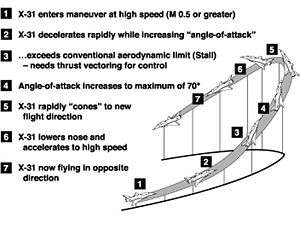Herbst maneuver

The Herbst maneuver (also known as a J-turn[1][2]) is an air combat maneuver that uses post-stall technology such as thrust vectoring and advanced flight controls to achieve high angles of attack.[3] The Herbst maneuver allows an aircraft to quickly reverse direction using a combination of high angle-of-attack and rolling. Though categorized with Pugachev's Cobra, which is popular at airshows, the Herbst maneuver is considered more useful in combat.[1]
The Herbst maneuver was named after Dr. Wolfgang Herbst, an employee of Messerschmitt-Bölkow-Blohm (MBB). Herbst was the initiator of the Rockwell SNAKE, which formed the basis for the Rockwell-MBB X-31 project,[4] and one of the original developers of post-stall technology.[3] The Herbst maneuver was first performed by an X-31 on April 29, 1993.[5]
See also
References
- 1 2 "Turn and Burn." Fulghum, D. A.; Fabey, M. J. Aviation Week & Space Technology. January 8, 2007.
- ↑ "X-31 Enhanced Fighter Maneuverability Demonstrator." Pike, J. GlobalSecurity.org.
- 1 2 Smith, R. E.; Dike, B. A.; Ravichandran, B.; El-Fallah, A.; Mehra, R. K. (2001). "Discovering Novel Fighter Combat Maneuvers in Simulation: Simulating Test Pilot Creativity" (PDF). United States Air Force. Retrieved 2007-01-16.
- ↑ "Partners in Freedom: Rockwell-MBB X-31." Langevin, G. S.; Overbey, P. NASA Langley Research Center. October 17, 2003.
- ↑ "X-31 at High Angle of Attack." NASA Dryden Flight Research Center. March 1, 1994
External links
- "X-31 in flight, Herbst maneuver." (NASA video)
- "X-31 Demonstrating High Angle of Attack - Herbst Maneuver." (NASA photo)
- USAF & NATO Report RTO-TR-015 AC/323/(HFM-015)/TP-1 (2001)